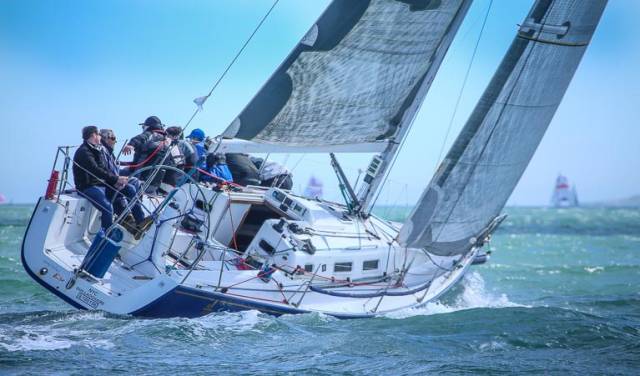Mark Mansfield, Professional sailor and UK Sailmakers Ireland agent, goes through some tips for improving your boat rating relative to its speed. Mark has been involved in many campaigns and projects from Quarter Tonners, Half Tonner, J109’s, Commodores Cup boats, where he has been tasked with the job of trying to improve the boat rating and come up with improvements that will be rating efficient.
Performing better on the race track can be as a result of a combination of things. Of course, newer, more modern and better sails will help significantly, but there are so many other areas that also can assist in making the boat go faster. I will touch on some of these briefly before going on to talk about improving the rating.
Hull Finish
Spend time ensuring the bottom finish is as good as possible. On smaller one designs, this likely would involve fairing the hull, keel and rudder to computer cut templates. However on most IRC boats, this will not be done, so just getting a really good sanded finish is paramount. Then, if antifouling is being applied, try and have it sprayed and, even after spraying, ensure it is lightly rubbed again with light sandpaper to remove the orange peel effect. Nautix does a very good hard antifouling that many race boats use and which can be sanded.
Rig Check
Ensure the rig is straight in the boat and at the correct tension. Your sailmaker will be able to advise you here if needed. Very many boats I have inspected recently turn out to have straight masts as you look up them, but the whole thing is all over to one side making the boat slow on one particular tack. This check requires very accurate measurement to make sure this is correct.
Remove weight
Make sure no unnecessary additional weight is carried aboard. Empty drawers, clear chart tables. Remove Pots, pans, knives and forks. Remove unneeded sails. It is incredible how much weight can accumulate. As a rule, on a 35-foot boat, about every 45 kgs of additional weight will cost you approx 4 seconds an hour. How often, in a 2-hour race, have you been beaten by a few seconds?
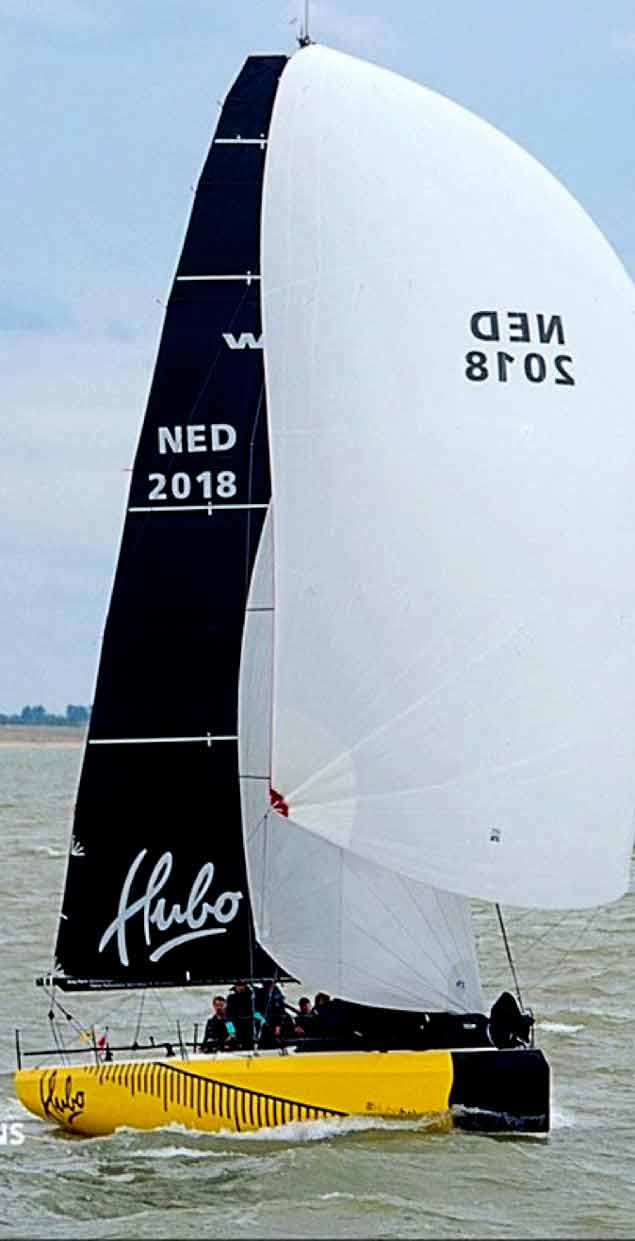 Hubo from Holland on her way to winning the Dutch IRC/ORC Nationals. Sails and IRC Optimisation work was completed by Barry Hayes of UK Sailmakers Ireland
Hubo from Holland on her way to winning the Dutch IRC/ORC Nationals. Sails and IRC Optimisation work was completed by Barry Hayes of UK Sailmakers Ireland
Rig Weight
Remove weight from the Rig. Modern Dyneema halyards are stronger, have less stretch and can be smaller in size. Weight up the mast is so important to heeling effect so a reduction in weight, even inside the mast is significant. If your backstay is a solid wire or Rod, why not look at changing it for a Dyneema one. An aluminium mast could be changed for a Carbon rig but will incur a penalty of 5 or 6 points on a 35 footer. If the mast was a standard carbon one, which might not be a whole lot lighter than an aluminium mast, then it is not likely worth the extra rating hit. If, however, you go for an Ultra-high Modulus Carbon mast, that might be a further 20 % lighter, then that likely would be worth it. The drawback is it is significantly more expensive. IRC does not differentiate between the two, hence the fancy new IRC race boats being built will generally go for an Ultra High Modulus Carbon Rig.
Smooth Systems
Make sure all your sail adjustment systems work smoothly and have enough purchase on them to adjust under load. In particular the Backstay, Jib car adjustment purchases, mainsheet travellers, mainsheet itself. These are the things that are adjusted most often, and they need to be easy to move and adjust with minimal load. Look at upgrading some blocks and purchases if you cannot adjust quickly.
Crew Numbers
Make sure you have enough Crew. Crew weight is moveable and is very efficient in breeze upwind. As long as you do not have a weight restriction, always go for as many as is reasonably possible. Weight is restricted on most one designs. There is a very good reason for that. Extra weight is fast. Also, make as much of an effort as is possible to lean out far. It really makes a difference. Look at the photo of Fools Gold Below to see how they hike and how many they have on the side.
Improving the IRC Rating
Firstly it is essential to understand that improving the IRC rating does not always mean reducing it. Sometimes adding sail area or reducing weight, may lead to an increase in the rating, but these changes may improve the speed by even more than the cost of the increased rating. Most sailors understand that one point in rating costs about 3.6 seconds an hour. However, it is 3.6 seconds if your rating is about 1.000. If your rating is around .900, then it is close to 4 seconds per point an hour. If your rating it around 1.100, then each point is only about 3.3 seconds an hour.
It is important to understand a yachts strengths and weaknesses, and only then can changes be made to the rating.
For example, if a yacht is particularly good in light airs but weak in a breeze, then it is possible that it has too much sail for all-round conditions. Reducing sail area may result in it being still good enough to win in the light, be as good if not better in the breeze, and have a 3 or 4 point rating reduction. Conversely, if a boat is very weak in the light and very good in the breeze, then extra sail area, leading to a higher rating, may be the way to go.
Changing sail area is one thing, but it is crucial that some decent advice is provided by your sailmaker or top sailor in this regard, particularly on whether to increase/decrease headsail or mainsail size. The balance of the helm is so vital in working out which sail the changes should be made to. In general, if your boat has a lot of weather helm, reduce your mainsail area (or increase your Headsail area). If you have little or no weather helm, increase your mainsail (or reduce your jib size).
In technical terms, this is called the Lead (pronounced Leed). It is the balance of the entire boat. Initially, this would be organised by the boat designer, in conjunction with the sailmaker. It represents where the mast is positioned in the boat compared to the keel and compared to the sail sizing. Often, as boats get older, and the configuration changes (say changing from overlapping to non-overlapping jibs), so does the Lead and often this change then should be balanced by changing rake, amending sail sizes or other changes.
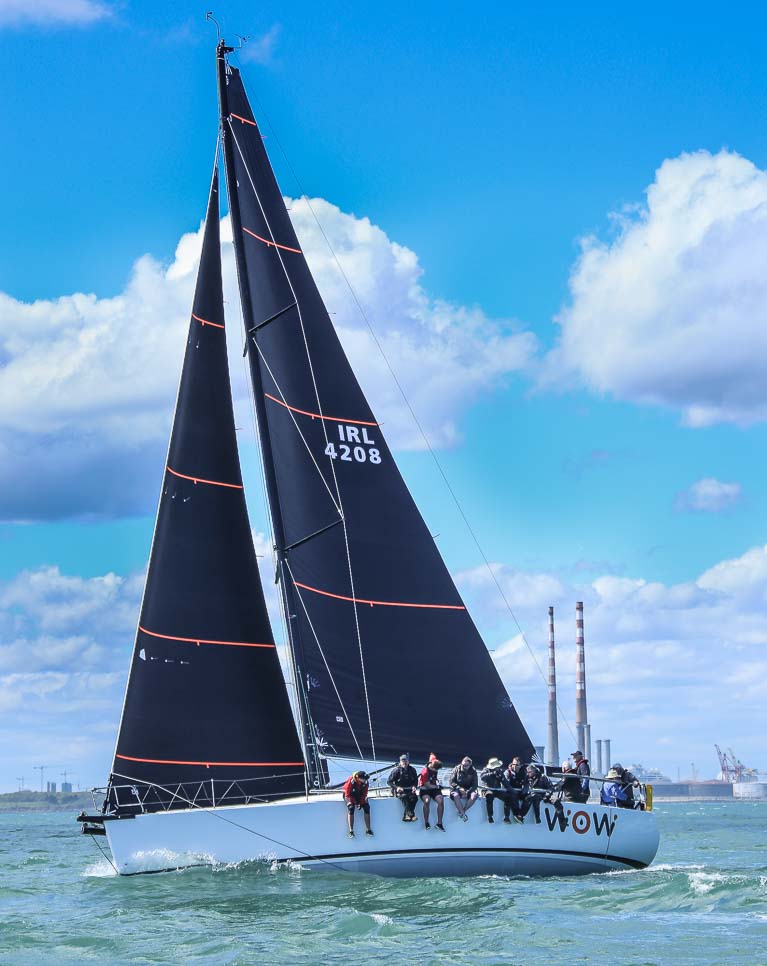 George Sisk's Farr 42, Wow, underwent some significant IRC changes over the winter including a new fin keel, deeper than her previous keel. Seen here going upwind with her new UK Sailmakers Ireland Uni Titanium Jib and Main Photo: Afloat.ie
George Sisk's Farr 42, Wow, underwent some significant IRC changes over the winter including a new fin keel, deeper than her previous keel. Seen here going upwind with her new UK Sailmakers Ireland Uni Titanium Jib and Main Photo: Afloat.ie
Other IRC Optimisation Handicap Tips
Always remember to remeasure your sails regularly. Modern laminate sails will shrink, particularly the luffs of your Jibs. Even sails that are only a month or two old can shrink and allow a reduction of 2 or 3 points on a 35-foot sized boat. It is worth the cost of this remeasurement to do it at least once during every season.
Spinnaker area is treated quite cheaply on IRC. On a 35 footer, you can get approx. 3 sq metres extra per point. If you have the capacity to increase your chute size, do it. Remember that a standard symmetrical spinnaker with a pole is allowed a specific length pole, without a penalty, based on spinnaker size. It is a formula and, though the formula is believed to be secret, it appears to be the square root of your SPA (spinnaker area) x .456. So a boat with a 100 sq. Metre spinnaker would have a 4.56 m pole, without penalty.
If you decide to increase your spinnaker area, it would be optimum also to increase your pole length. This should make the boat quicker for having more sail, and it will also make it quicker for having a longer pole as the further you can get the pole away from the rig, the faster the boat will go.
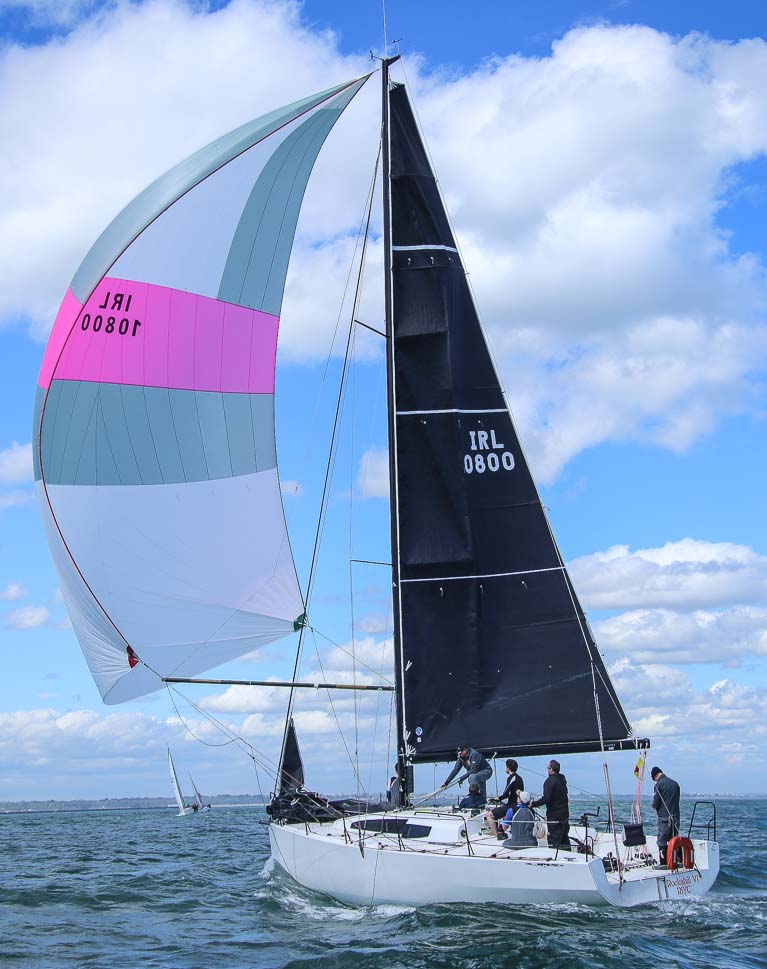 Paul O'Higgins Rockabill VI with her new S2 UK Sailmakers chute in May, which was bigger than her 2017 chute. In this photo, the pole had not yet been extended. Photo: Afloat.ie
Paul O'Higgins Rockabill VI with her new S2 UK Sailmakers chute in May, which was bigger than her 2017 chute. In this photo, the pole had not yet been extended. Photo: Afloat.ie
In the case of an asymmetric spinnaker, it is not as simple. The formula for this is not well known and only trial certs, sent into the rating office, can answer this question. For example, I have looked at about 20 different J109 certs, and there eventually comes a realisation of what the best sprit length should be, which in the case of a J109 involves restricting it’s length when sailing under IRC.
The displacement of a yacht is also significant. If a yacht is very tippy in the breeze, adding weight in the form of lead can settle the boat down upwind, as the extra weight will also add a little length to the boat as it sits down further, and in a breeze the longer you are, the faster you will go.
This extra weight can be added easily in the bilge in lead, or could even be added to the bottom of the keel if the design allowed it. Very many quarter tonners and half tonners have added keel extensions, but this is easy for them as their keels are similar shape all the way down. In general, an extra 150 or 200 mm on the bottom of the keel is virtually rating neutral as the extra weight(say 100kgs in a half tonner), is equal to the penalty with the extra draft. What it does is make the boat faster upwind in a breeze, but it is maybe not quite as fast then in Light airs. If weight was only added in the Bilge, it appears that every 1% of weight added equates to about 1 point of rating approximate reduction. So say in a quarter tonner(1400 Kgs), you add 60 kgs in the Bilge, you should get circa 4 points back. It appears there is no penalty for adding lead, up to approx 5 % of a boat displacement. After that, the gain brought by adding lead as weight (one point per 1% approx of weight added) is lessened by these extra penalties.
Sail sizing has got to be checked. Under IRC specifically sized mainsails will have default girth (width)sizes which do not involve a penalty. The sailmakers well know these. The length of the Luff is not measured as the black bands restrict these on the Boom end (E measurement) and at the top of the mast (P measurement). Only the girths and headboard form the mainsail measurement. For boats that do not bring their P measurement all the way to the top but have wide girths, it would likely be better to reduce the Girths in the Main and have a longer luff, to avoid the extra penalties.
With headsails, it seems to appear that not going full length on your Jib Luff(called LL) is treated well by IRC. Trial certs on this have produced good rating reductions.
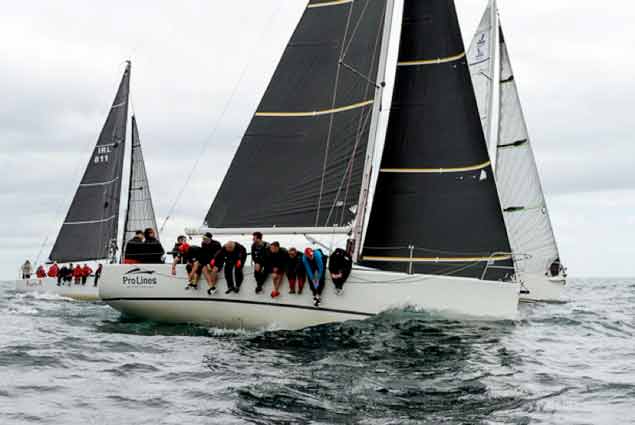 Rob McConnell's Fools Gold, sporting full UK Sailmakers Ireland Carbon Uni Titanium Main and Headsail on her way to winning Sovereigns week 2017. She benefited on her IRC handicap from a slight Jib luff length(LL) reduction. Photo: Bob Bateman
Rob McConnell's Fools Gold, sporting full UK Sailmakers Ireland Carbon Uni Titanium Main and Headsail on her way to winning Sovereigns week 2017. She benefited on her IRC handicap from a slight Jib luff length(LL) reduction. Photo: Bob Bateman
However, some boats cannot afford any reduction in their headsail sizes. Many boats are now only using non-overlapping Jibs but were originally designed with much larger overlapping Jibs. Examples of these would be J109’s. Beneteau 34.7’s. Half tonners, Quarter Tonners. In the case of the last 2 (half and Quarter tonners), the masts are generally moved further back when they are modernised, as are the Keels, to allow more foretriangle area. In the case of these, lowering the Jib LL(luff length )may be a good option. In the case of the J109 and Beneteau 34.7, the masts are not moved, nor are the keels, so it is important, for the balance of the boat, to maximise the full foretriangle area and so lowering the LL for them is not such a good idea.
Headsail Furlers are not efficient under IRC. There is a small rating gain if you use one large roller headsail plus a very small working Jib. However, this is too restrictive. If you use a roller headsail, even with battens and in a high tech material, it will give you no extra rating benefit and will not be as efficient as a non-roller Headsail. This is because a non-roller Headsail can have long horizontal battens all the way up which allows the sail to have more roach. The sail is also low to the deck which then will get a better airflow on the bottom part of the sail(called end plate effect). Generally, it is more difficult to change a Jib on a roller, so the sails are made more all-purpose, whereas a boat, without a roller may have specific Jibs which they can change for different wind conditions. All this being said, there are boats out there that do well on IRC with rollers. My point is they would likely do even better without them.
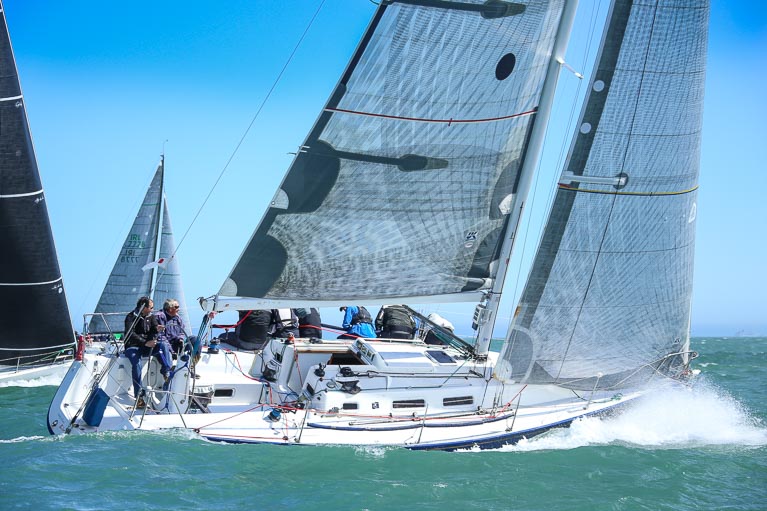 Brian and John Hall's J109, Something Else from Dun Laoghaire with her all-purpose roller headsail. Sails provided by UK Sailmakers Ireland. Photo: Afloat.ie
Brian and John Hall's J109, Something Else from Dun Laoghaire with her all-purpose roller headsail. Sails provided by UK Sailmakers Ireland. Photo: Afloat.ie
Bow down trim can be advantageous on IRC boats, especially if the bow of the boat is already in the water, or very close to it. The reason for this is extra weight placed forward(perhaps lead) will not add a lot of length at the bow, but will lift the stern a lot more. This results in the rated length coming out shorter and so a rating advantage.
Sailmakers have access to the sail size data for all IRC boats, so when owners want to look at changing their sail sizing, the sailmaker can look up successful models of this design which compete elsewhere(maybe the Uk, Maybe France, Holland). This allows them to see precisely what has been working well on other boats and then replicate this for their customer. That is why it is always best to discuss what one wants to do with your sailmaker as they have access to extra valuable information which you may not have.
Getting a boat measured is sometimes regarded as a bit of a Dark art. There is a lot of stories of 'SPECIAL' measurers being less observant or stretching the measuring tape etc. The reality is that to get a good measuring, you need to know what to expect and try and make whatever changes you can in advance, to ensure you get the figures you expect. That means when it is being measured, you know every one of the measurements being taken and if the figure comes out differently, then you query it. Sometimes it can just be a simple mistake, but then is the time to rectify it, not later when you get the rating cert back.
Finally, when you get the cert back, go through every figure and section. If you don’t know what you are looking at, get someone else that does. It is not unknown for there to be inputting errors that can make a substantial difference. Much of the data on the cert involves sail sizing, so your experienced sailmaker, who is used to working with the IRC rule, would be the best one to help you with all this.
At UK Sailmakers Ireland we have three top professional level sailors, two of which are sailmakers, who can help with all the rating optimisation needs. Mark Mansfield is a four times Olympian and has been competing at a high international level on IRC and one design for over 30 years. Barry Hayes, before moving back to Ireland, previously ran the UK Sailmakers Worldwide production facility in Hong Kong and had significant experience over there working on IRC projects. Graham Curran has significant experience in Ireland working on IRC projects, including Fools Gold, which he also sails on.
You should get your sails measured by an In-House Certification (IHC) sail loft so your sails are endorsed and measured by certified IRC - ORC and ISAF professionals. UK Sailmakers Ireland is the only IHC loft in the country.
Contact us if you think we can help with your boat, either by making it faster with new sails or also by helping with your IRC rating.


























